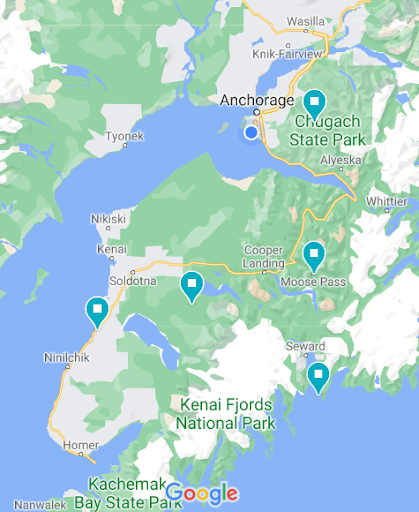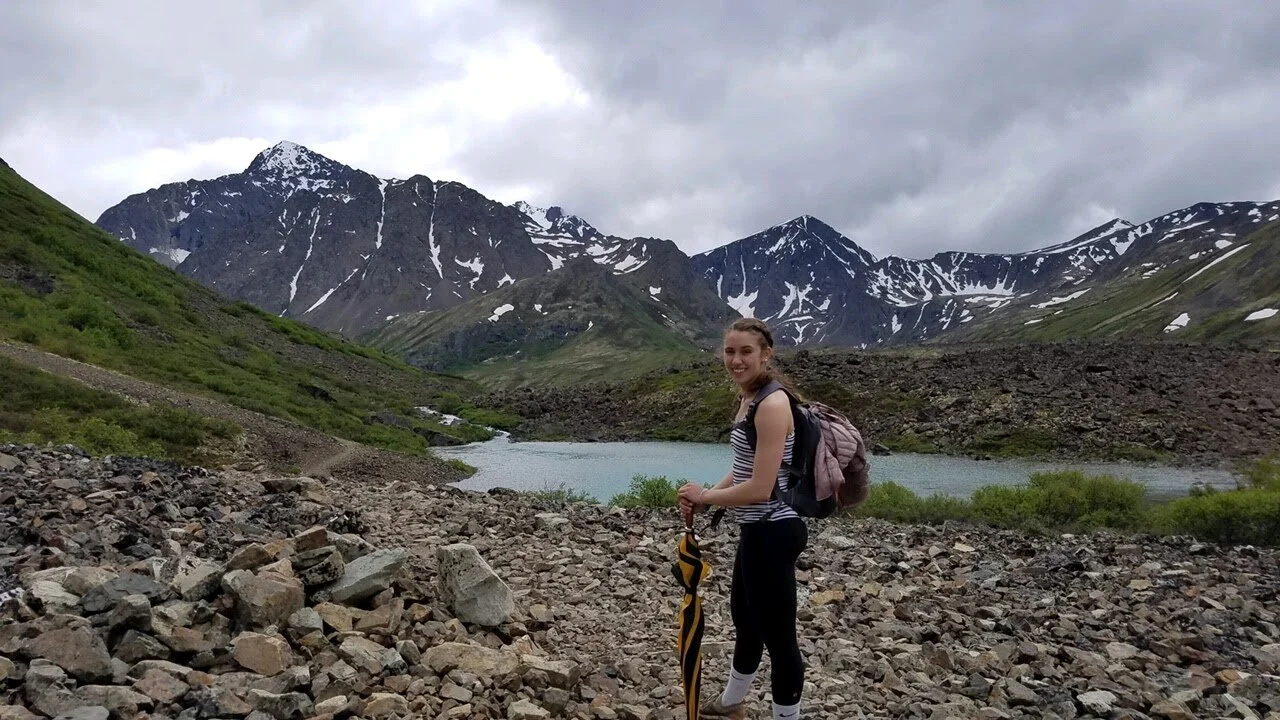On the Road With Hannah: Southcentral Exploration
By Hannah Pembroke
Hello wildlife lovers! Over the next few weeks, I have a great road trip for us planned where we will explore the various towns, islands, lakes, and rivers in Alaska whose names were inspired by wildlife. The foundation animals have provided for the survival and success of Alaskan communities is well reflected in the historical names of all types of locations throughout our great state. From wolves, fish, elephants, bears, and birds, in Alaska you can find just about any animal used as a name. This week, we will be looking specifically at the Southcentral region!
Eagle Lake
To kick off our trip, we will begin just east of Anchorage at Eagle Lake. Eagle Lake presents a wonderful opportunity to hike out in the Alaskan nature, ripe with wildlife! While the lake is located on lands of the Dena’ina people, the USGS did not record the Deni'ana Athabaskan name for Eagle Lake. An influx of homesteaders and an army base provided the context for the English name. This gorgeous emerald-hued lake first dawned its modern name in 1942 from officials of the Kenai Moose Range, who were inspired by the Northern Bald Eagle. However, it was the Army Map Service that first published it. Connected to this beautiful mountain lake is Eagle River, which was named in a similar fashion and was the inspiration for the nearby city, also named Eagle River. While there are now fewer eagles than when the Kenai Moose Range first named the lake, these majestic birds still offer plenty of inspiration and wonder for locals and tourists alike. Make sure to pack some binoculars! Hopefully we will see the name-sake Bald Eagle on this stop of our trip.
Moose Pass
Next up, we will be heading down around Cook Inlet till we are just north-east of Kenai Lake, traditionally known as Sqilan Bena. Surrounded by Chugach National Forest, we arrive in Moose Pass! While Moose Pass does not have a Dena’ina name listed by USGS, this area was home to the Dena’ina people long before this little town was nicknamed “Moose Pass.” The English name was given by early European Explorers in 1903, after one unlucky mail carrier and his team of sled dogs had an unexpected delay on their route when an impressively large moose stopped the team and refused to let them pass. It’s no surprise the name stuck, after all, it would be hard to find a more Alaskan anecdote than that! It wasn’t until 1912 however, that Moose Pass grew into its name and became a station on the Alaskan Railroad. The name became official in 1928, when Moose Pass finally got its own Post Office, making the difficult task of fighting for right-away with a moose a bit easier. To this day, Moose Pass is a great spot for wildlife spotting, fishing, and flying services! If we are lucky, maybe our drive through will be slowed down by a curious furry friend.
Shantatlik Creek
Originally named Shanteh K’eleht by the Dena’ina people, Shantatlik Creek is connected to Tustumena Lake and curves just above Fox Lake (don’t worry, we’re visiting there too). The name Shanteh K’eleht, meaning “the summer fish run place”, may not specifically be named after a type of fish, or even fish as a species. However, this unique name captures the respect and reliance the Dena’ina people have for fish. While the name has been anglicized by the influx of trappers and explorers during the 1900s, its importance has not changed. Understanding and predicting when and where fish run means the difference between survival and starvation. In 2021, in the Southcentral region of Alaska, the scenario may no longer be so drastic, however when Shanteh K’eleht became Shantatlik Creek, it certainly was. This beautiful creek is still a great fish run, as its name implies, so be sure to bring your favorite fishing pole for this stop!
Clam Gulch
If you are looking for an opportunity to harvest some of your own seafood on this trip, this stop will be sure to satisfy your hunger! Recognized as Qałnigi Dnazdlut by the Dena’ina people, Clam Gulch was given its English name for its abundance of razor clams, however this is one of the more recently added locations for Alaskan tourists. In recent years, clamming has been shut down due to depleted numbers. Prior to the 1940s, there was no road access to Clam Gulch, leaving the name unofficial and the razor clam digging for locals only. Similar to how Eagle Lake and Eagle River were named, Clam Gulch and Clam Gulch Ravine were named by Barnes and Cobb of the U.S. Geological Survey, who drew from wildlife as a source for the name of these locations. While the USGS did not record the Deni'ana Athabaskan name for Clam Gulch, the coastal location and abundance of clams offers no confusion for why people are drawn to the gulch. Get ready to get a little dirty, because for this stop we will practice eating what the land has to offer, and join the locals in digging for our dinner!
Fox Island
Our last stop for this week requires us to hop, skip, and jump through the Aleutian Islands, to Fox Island. While all of our stops thus far have been quite spectacular, Fox Island is truly breathtaking. Complete with gorgeous views of Resurrection Bay, it is no surprise that early European Explorers were just as curious as modern-day tourists to explore the beautiful land! The island’s first recorded name by the USGS was given by European explorers in 1904. Prior to the arrival of Russian and European explorers, Fox Island was home to the Aleut people and maintained a rich culture of storytelling and oral traditions, including its original name which is unfortunately not listed by the USGS. Though the land had several names during its early years on the map, and was named in several different languages, the most popular ones all roughly translated to “fox.” This inspiration came from the large fox farm that was present on the island. The island provided work and trade for the explorers, who would take their smaller boats and sail into Seward for supplies and trade. This fox farm, ran by a Swedish explorer turned Alaskan Sourdough, was home to Rockwell Kent for a winter in 1918, providing him a muse which inspired a well-kept journal and several pieces of art that invited the lower 48 to view Alaska as the beautiful, wild place that it is. From Lowell Island, Renard Island, and now Fox Island, what a wonderful way to finish our road trip. Get ready for some hikes and great fresh seafood, because here on the island we will have plenty of both.
Thank you for checking in this week for the Southcentral leg of our journey! As always, it is a privilege and joy to experience the land around us and to witness wildlife in its natural habitat. If you are interested in aiding our goal of protecting Alaskan wildlife, please become a member.
See you next week, when we are back on the road with Hannah!







